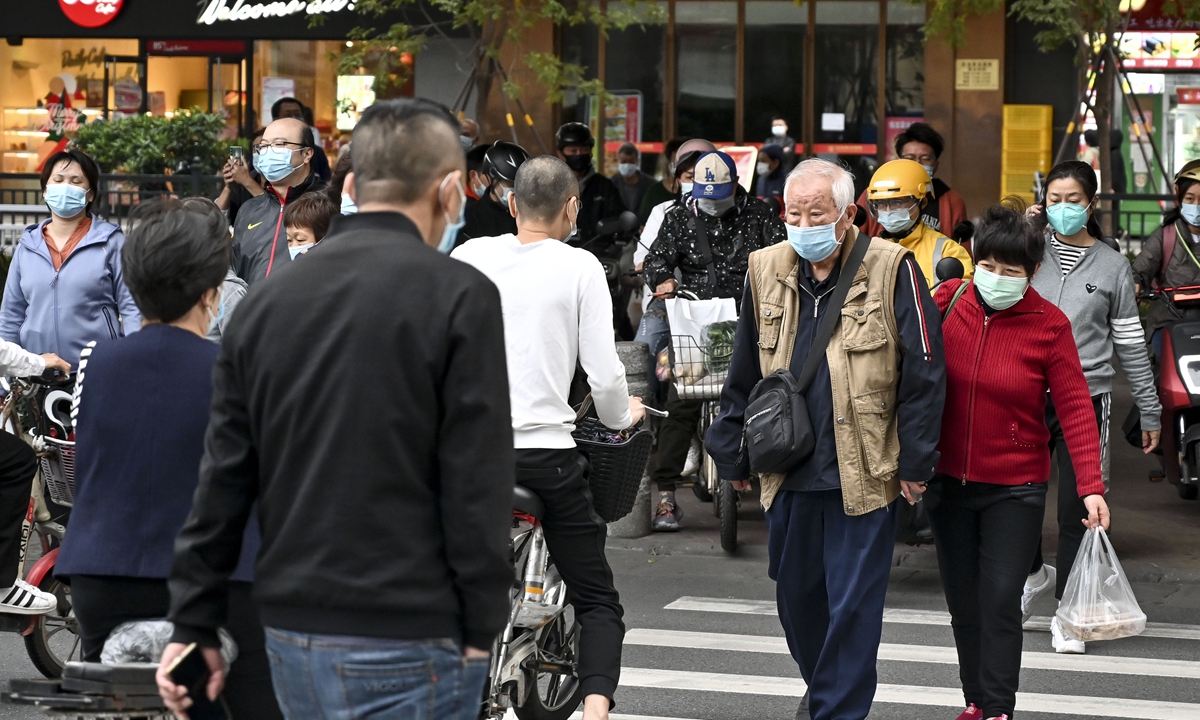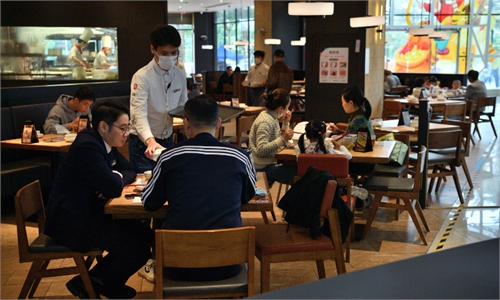
People walk on the street in the Haizhu district, Guangzhou, South China's Guangdong Province, on November 30, 2022. Photo: VCG
Chinese cities including Beijing, Guangzhou and Chengdu, where the virus is rife, have continued to optimize their anti-epidemic policies in recent days, with Guangzhou resuming businesses, allowing dine-in services in low-risk areas; and shopping malls gradually opening in Beijing starting Thursday. Some cities have also started to allow close contacts to have home quarantine under certain conditions and exempt some groups from routine nucleic tests.
Chinese Vice Premier Sun Chunlan underlined again on Thursday the importance of continuously optimizing China's response to COVID-19, following similar remarks she made on Wednesday saying the country is facing a new situation and new tasks in epidemic prevention and control as the pathogenicity of the Omicron virus weakens.
Epidemiologists said such optimized measures aims to strike a better balance between COVID-19 control and ensuring people's normal lives. Allowing home quarantine for some risk groups also relieves pressure of already strained hospital resources.
Sun listened to frontline medical workers' opinions and suggestions on improving epidemic containment measures, the Xinhua News Agency reported on Thursday.
Sun noted that having effective medicine, especially traditional Chinese medicine, vaccination of more than 90 percent of the whole population; and declining pathogenicity of the Omicron virus, have created the condition for further optimizing COVID-19 responses. She urged frontline workers to properly handing COVID-19 prevention and quickly respond to people's concerns.
On Wednesday, Sun said more people have been vaccinated and there is a lot of experience in containing the virus.
China reported 4,080 new COVID-19 cases on Thursday, and 31,720 asymptomatic cases. Cities such as Guangzhou, Beijing and Chongqing are among the hardest-hit.
Yet those cities are shifting away from using long-term lockdowns to rein in the contagion and are optimizing their COVID-19 responses in line with current conditions.
Several districts in Beijing have announced that people who stay at home and don't have to go to public places can now opt not to take routine nucleic acid tests, an approach designed to achieve a more precise way to reduce spreading risks and also conserve resources.
Multiple shopping centers in the Chinese capital also announced that they are reopening from Thursday, and visitors need to present a negative nucleic acid test result taken within 48 hours when entering the shopping centers.
Districts in Guangzhou, capital city of South China's Guangdong Province, on Wednesday issued notices on optimizing anti-COVID measures, including lifting temporary restrictions, adjusting risk regions' classification, and resuming on-site classes. Some areas in Guangzhou also resumed dine-in services, and residents only need to show their health code and they don't have to present negative nucleic acid testing reports when entering some shopping malls.
Guangzhou on Thursday also asked residents to prepare antigen test kits for COVID-19.
Authorities of Shenzhen, a metropolis near Guangzhou, said on Wednesday that close contacts shall be placed under centralized quarantine in principle, and those who meet the conditions for home quarantine are allowed to be quarantined at home.
A Beijing-based epidemiologist who requested anonymity told the Global Times on Thursday that allowing close contacts and positive cases home quarantine, if they meet certain standards, such as having independent rooms and toilets, can help relieve the already strained medical resources when cases are surging.
The possibility that the virus transmit through ventilating system of residential buildings is very low, said the expert, who still urged close health monitoring of those under home quarantine in case their situations worsen and more intense care is needed.
Future focuses
When some medical resources are partly released by those optimized measures, they can be focused on treating severe cases and pushing forward inoculation, especially among the elderly, Wang Guangfa, a respiratory expert at Peking University First Hospital, told the Global Times on Thursday.
Wang said that China is facing a "severe situation" in battling the COVID-19. Wang pointed out that since the currently dominant Omicron has far weaker pathogenicity, sticking to the previous COVID control playbook will cast great pressure on the medical system, which should divert its focus on the treatment of severe cases.
A total of seven deaths triggered by COVID-19 were reported in November, among whom the youngest was 81-year-old. All of them had underlying diseases, media reported.
Chinese health officials and experts have been repeatedly calling on the elderly to get vaccinated.
According to the National Health Commission, more than 90 percent of those who are aged 60 years old received the first dose of the vaccines.
For those aged 80 and above, about 27.4 million had accepted at least one shot and about 23.6 million completed full vaccinations, accounting for only 76.6 percent and 65.8 percent, respectively, of the whole group, Xia Gang, an official from the national disease control and prevention bureau under the National Health Commission, said at a press conference on Tuesday.

